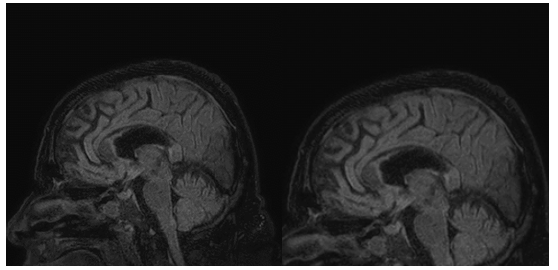Case Report 
 Creative Commons, CC-BY
Creative Commons, CC-BY
Cytotoxic Lesion of The Corpus Callosum Presenting with Alien-Hand Syndrome
*Corresponding author: Fabian H Rossi, Department of Neurology, Orlando VA Medical Center Professor Neurology UCF Medical School, Orlando, USA.
Received: April 02, 2024; Published: April 11, 2024
DOI: 10.34297/AJBSR.2024.22.002917
Case Report
60-year-old gentleman with end-stage renal disease, on hemodialysis, was admitted to the hospital for urinary tract infection and pneumonia, complicated with respiratory insufficiency requiring mechanical ventilation. Blood tests showed leukocytosis with neutrophilia, elevated creatinine [9.4 mg/dL], reduced glomerular filtration rate [estimated glomerular filtration rate 5-7ml/min], hyponatremia [130meq /L], elevated glucose 494mg/dL and C-reac tive protein [9.3mg /dL]. COVID-19 was negative. A few days later while still in the ICU, he developed a left arm Alien Hand Syndrome [AHS] with an ideomotor apraxia with normal attention, orientation, language, and motor function. Brain MRI showed edema with local mass on the splenium of the corpus callosum [Figure 1 A-B, 2A]. Four months later as his respiratory condition, infections and glucose get under controlled his alien hand syndrome, ideomotor apraxia and MRI findings resolved [Figure 2 B].

Figure 1A-B: DWI (A) and ADC (B) images of the brain demonstrate edema with restricted diffusion of the corpus callosum with local mass effect (Arrows).

Figure 2A-B:A: Sagittal FLAIR image demonstrating edema of the dorsal portion of the corpus callosum. B: Sagittal FLAIR image follow-up MRI of the Brain four months later, demonstrating loss of volume of the affected region (arrows).
Cytotoxic Lesion of the Corpus Callosum [CLOCC] is a rare cytokinopathy caused by several etiologies such as metabolic disturbances, trauma, toxicity, drug-related, malignancies, bacterial or viral meningoencephalitis, including COVID-19 infection; or their combination [1-4]. CLOCC may present with different non-specific neurological features including confusion, drowsiness, delirium, aphasia, behavioral changes, and seizures [1,2]. However, AHS was hardly ever the main neurocognitive presentation of CLOCC, like in this case [5,6]. In CLOCC brain MRI showed a characteristic lesion in the splenium of the corpus callosum with variable involvement of the remaining of the corpus callosum and/or white matter [1,2,]. CLOCC usually has a benign and reversible course as its etiologies are treated; as seen here, where the AHS and MRI features resolved completely in months. CLOCC results from cell activation and release of excitatory cytokines and glutamate, leading to water retention in the cells and cytotoxic edema [1,2,7]. The splenium of the corpus callosum has high density of cytokines and glutaminergic receptors, making this region most vulnerable for this cytokinopathy [2]. No specific therapy exists other than addressing its potential etiology and supportive care [2,8].
AHS is a phenomenon characterized by involuntary and autonomous activity of the affected hand where the patient loses control of his/her hand as if it has its own mind. Patients may present with involuntary complex-goal-directive activities executed without volitional control or sensory awareness [9]. AHS could be cause by damage of the corpus callosum, posterior parietal cortex; and supplementary motor area, anterior cingulate cortex, and medial prefrontal cortex [10]. Among the most common etiologies are surgery, tumors, aneurysm, stroke, neurodegeneration such as cortico-basal- ganglionic degeneration and Alzheimer’s dementia [10,11]. The mechanism how CLOCC leads to AHS remains unknown, but AHS is best explained as a hemispheric disconnection syndrome where behaviors requiring dominant-hemispheric control led to two hemispheres with independent volition [10-12]. CLOCC is a clinical-radiographic syndrome that should be considered among the possible etiologies of an acute or subacute AHS.
Acknowledgements
None.
Conflicts of Interest
None.
References
- Tetsuka S (2019) Reversible lesion in the splenium of the corpus callosum. Brain Behav 9(11): e01440.
- Starkey J, Kobayashi N, Numaguchi Y, Moritani T (2017) Cytotoxic Lesions of the Corpus Callosum That Show Restricted Diffusion: Mechanisms, Causes, and Manifestations Radiographics 37(2): 562-576.
- Edjlali M, Le Gal A, Louvet M, Matt M, Leveque C, et al. (2020) Cytotoxic lesions of the corpus callosum in encephalopathic patients with COVID-19 Neurology 95 (22): 1021-1022.
- Gaur P, Dixon L, Jones B, Lyall H, Jan W (2020) COVID-19-Associated cytotoxic lesions of the corpus callosum. AJNR Am J Neuroradiol 41(10): 1905-1907.
- Yuan JL, Wang SK, Gui XJ, Hu WJ (2011) Acute infarct of the corpus callosum presenting as alien hand syndrome: evidence of diffusion weighted imaging and magnetic resonance angiography. BMC Neurol 11: 142.
- Gellman SR, Ng YT (2018) Transient corpus callosal lesion presenting with alien hand syndrome Pediatr Neurol 89: 66-67.
- Moors S, Nakhostin D, Ilchenko D, Kulcsar Z, Starkey J, et al. (2023) Cytotoxic lesions of the corpus callosum: a systematic review Eur Radiol.
- Zhang S, Ma Y, Feng J (2015) Clinicoradiological spectrum of reversible splenial lesion syndrome (RESLES) in adults: A retrospective study of a rare entity. Medicine (Baltimore) 94(6): 512.
- Xiaoyu Gao, Bing Li, Wenzheng Chu, Xuwen Sun, Chunjuan Sun (2016) Alien hand syndrome following corpus callosum infarction: a case report and review of the literature. Exp Ther Med 12(4): 2129-2135.
- Manea MC, Iliuta FP, Manea M, Lacau RM, Varlam CJ, et al. (2024) Alien hand syndrome: pathophysiology, semiology, and differential Diagnosis with psychiatric disorders- (Review). Biomed Rep 20(5):74.
- Panikkath R, Panikkath D, Mojumder D, Nugent K (2014) Alien Hand Syndrome. Proc (Bayl Univ Med Cent) 27(3): 219-220.
- Kikkert MA, Ribbers GM, Koudstaal PJ (2006) Alien hand syndrome in stroke: a report of 2 cases and review of the literature. Arch Phys Med Rehabil 87(5): 728-732.



 We use cookies to ensure you get the best experience on our website.
We use cookies to ensure you get the best experience on our website.